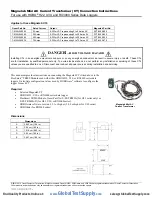
11
Alignment
Introduction and Precautions
The
FT-8800R
has been carefully aligned at the factory
for the specified performance across the 144 MHz and 430
MHz amateur bands. Realignment should therefore not
be necessary except in the event of a component failure.
All component replacement and service should be per-
formed only by an authorized Vertex Standard represen-
tative, or the warranty policy may be voided.
The following procedures cover the sometimes critical and
tedious adjustments that are not normally required once
the transceiver has left the factory. However, if damage
occurs and some parts are replaced, realignment may be
required. If a sudden problem occurs during normal op-
eration, it is likely due to component failure; realignment
should not be done until after the faulty component has
been replaced.
We recommend that servicing be performed only by au-
thorized Vertex Standard service technicians who are ex-
perienced with the circuitry and fully equipped for re-
pair and alignment. Therefore, if a fault is suspected, con-
tact the dealer from whom the transceiver was purchased
for instructions regarding repair. Authorized Vertex Stan-
dard service technicians realign all circuits and make com-
plete performance checks to ensure compliance with fac-
tory specifications after replacing any faulty components.
Those who do undertake any of the following alignments
are cautioned to proceed at their own risk. Problems caused
by unauthorized attempts at realignment are not covered
by the warranty policy. Also, Vertex Standard must re-
serve the right to change circuits and alignment procedures
in the interest of improved performance, without notify-
ing owners.
Under no circumstances should any alignment be attempt-
ed unless the normal function and operation of the trans-
ceiver are clearly understood, the cause of the malfunc-
tion has been clearly pinpointed and any faulty compo-
nents replaced, and the need for realignment determined
to be absolutely necessary.
Required Test Equipment
The following test equipment (and thorough familiarity
with its correct use) is necessary for complete realignment.
Correction of problems caused by misalignment result-
ing from use of improper test equipment is not covered
under the warranty policy. While most steps do not re-
quire all of the equipment listed, the interactions of some
adjustments may require that more complex adjustments
be performed afterwards. Do not attempt to perform only
a single step unless it is clearly isolated electrically from
all other steps. Have all test equipment ready before be-
ginning, and follow all of the steps in a section in the or-
der presented.
Regulated DC Power Supply: adjustable from 11.5 to
16 VDC, 10 A
RF Signal Generator with calibrated output level at
500 MHz
Frequency Counter: ±0.1 ppm accuracy at 500 MHz
AF Signal Generator
SINAD Meter
Oscilloscope
Spectrum Analyzer
Deviation Meter (linear detector)
AF Milivoltmeter
AF Dummy Load: 8-Ohm, 5 W
DC Voltmeter: high impedance
Inline Wattmeter with 5% accuracy at 500 MHz
50-Ohm non-reactive Dummy Load:
100 watts at 500 MHz
VHF/UHF Sampling Coupler
Set up the test equipment as shown for the transceiver
alignment, and apply 13.8 VDC power to the transceiver.
Alignment Preparation & Precautions
A dummy load and inline wattmeter must be connected
to the main antenna jack in all procedures that call for
transmission, except where specified otherwise. Correct
alignment is not possible with an antenna. After complet-
ing one step, read the following step to determine wheth-
er the same test equipment will be required. If not, re-
move the test equipment (except dummy load and watt-
meter, if connected) before proceeding.
Correct alignment requires that the ambient temperature
in the repair shop be the same as that of the transceiver
and test equipment, and that this temperature be held
constant between 68 °C and 86 °F (20 °C ~ 30 °C). When
the transceiver is brought into the shop from hot or cold
air it should be allowed some time for thermal equaliza-
tion with the environment before alignment. If possible,
alignments should be made with oscillator shields and
circuit boards firmly affixed in place. Also, the test equip-
ment must be thoroughly warmed up before beginning.
Notes
: Signal levels in dB referred to in alignment are
based on 0 dBµ = 0.5 µV (closed circuit).
DUAL B AND FM TRANSCEIV ER
FT-8800R
Power Supply
13.8 VDC
Pin 5
EXT SP
Frequency
Counter
Deviation
Meter
Inline
Wattmeter
50-ohm
Dummy Load
RF Sampling
Coupler
RF Signal
Generator
8-ohm
Dummy Load
SINAD
Meter
AF Signal
Generator
Содержание FT-8800E
Страница 4: ...4 Exploded View Miscellaneous Parts Note...
Страница 5: ...Block Diagram 5...
Страница 6: ...Block Diagram 6 Note...
Страница 16: ...16 Note...
Страница 18: ...MAIN Unit 18 Note...
Страница 44: ...44 MAIN Unit Note...
Страница 45: ...45 PANEL Unit Circuit Diagram...
Страница 50: ...50 PANEL Unit Note...
Страница 51: ...51 PANEL SUB Unit Circuit Diagram...












































